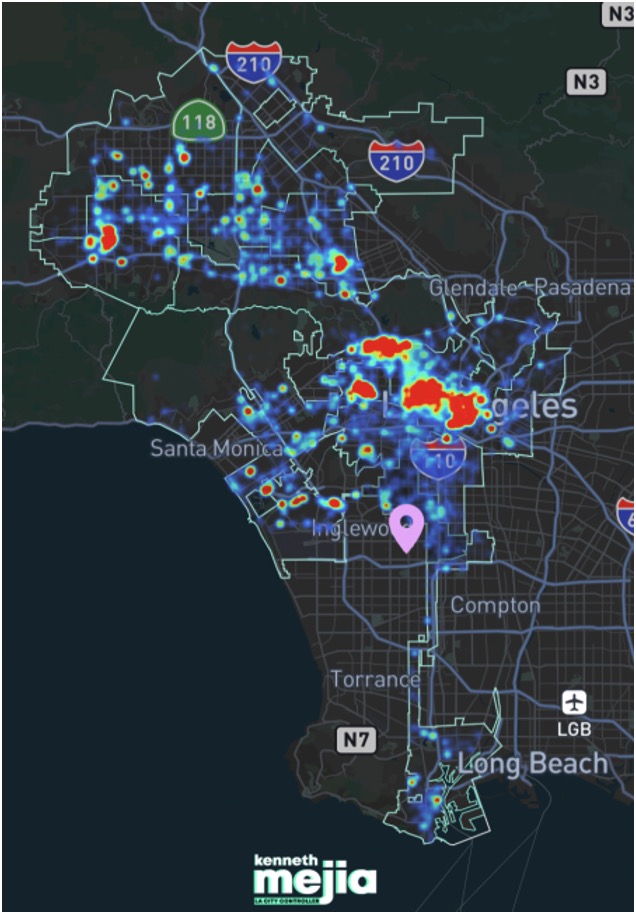Comments
PLANNING WATCH - In Los Angeles City Hall faces an irreconcilable dilemma.
On one hand, the elected officials and their backroom savants are dedicated members of the Urban Growth Machine, a political alliance of lenders, real estate speculators, lobbyists, academics, corporate media, and some civil servants and construction unions. They enthusiastically support the Urban Growth Machine’s main tenets:
- Local government should promote profit-driven real estate projects.
- All housing should be privately owned and managed, including public housing formerly funded by the Federal Department of Housing and Urban Development (HUD) and the local Los Angeles Community Redevelopment Agency (CRA).
On the other hand, most Angelenos hold local elected officials responsible for the homeless crisis, few people understand that the housing crisis results from the application of the Urban Growth Machine policies to Los Angeles (and other cities, too). In practice, the city’s adopted policies of upzoning and deregulation have driven up the cost of existing housing, increasing the rolls of the unhoused and over-crowded.
To escape these contradictory forces, City officials refuse to admit that the growing numbers of unhoused, overcrowded, and displaced residents result from increased rents that are beyond their ability to pay. Instead, local officials and other Urban Growth Machine’s supporters claim that homelessness and overcrowding result from addiction and mental illness, ignoring the obvious. According to the National Alliance of Mental Illness (NAMI), 10,000,000 people in the US suffer from severe mental illness and/or addiction, yet only a small percentage end up homeless. The rest are housed, despite their illnesses.
A medical researcher on homelessness, UCSF’s Dr. Margaret Kushel, contends that this mental illness and addiction explanation is simply wrong. Compared to other states, California has a low rate of mental illness and a high rate of homelessness. She contends the real reason for California’s homeless crisis is obvious and confirmed by her research. California has expensive housing, and the high cost of housing forces many people into homelessness.
Dr. Kushel also refutes another widespread claim: California’s homeless crisis results from homeless people moving to the state. She wrote, “The rate of homelessness in a community varies with the costs of and availability of rental housing.”
Dr. Kushel’s research also helps explain City Hall’s inability to find a sweet spot that balances homelessness, rent increases, and evictions. Elected officials are unable to support the Urban Growth Machine’s policies and also avoid blame for the resulting growth of homelessness and overcrowding. After all, the City Council can only postpone rent increases and evictions for so long, even though these actions make the housing crisis worse.
Evictions, which were on hold since 2020, when the Covid 19 Pandemic began, have slowed the increase in homelessness in California. To do this, though, one of the Urban Growth Machine’s constituents, small landlords, took a financial hit. But by finally addressing their financial concerns, the City Council has also made the housing crisis worse. For example, the LA Times, a good windsock on trends in real estate speculation, recently editorialized that rent increases and evictions must resume. Their argument rests on the claim that landlords provide rental housing in Los Angeles. Apparently, the Los Angeles Times forgot that HUD and CRA public housing – including one million remaining units -- still provides non-market alternatives to rent increases and evictions.
How do evictions play out in Los Angeles Between January to July 2023, Los Angeles landlords sent out 40,000 eviction notices to tenants in 8,400 buildings. Furthermore, as of July 2023, LA’s Housing Department also had a backlog of 5,000 more eviction cases it needed to process. In combination, these evictions could double LA’s homeless population, a tradeoff for the City Council to finally allow rent increases and evictions.

The new City Controller, Kenneth Meiji, has mapped these eviction notices. The Controller’s map, shown above, reveals that the main centers of likely evictions are Warner Center, Hollywood, Macarthur Park, Miracle Mile, and DTLA. These spots are also centers for the construction of new high rise, high rent apartment towers. When these two maps are overlaid, the outcome is clear. Successful evictions would allow real estate speculators to clear tenants from sites likely to sprout new, highly profitable, high-rent apartment buildings.
Some of the City Council members are aware of this connection, but their solution makes little difference. On November 14, 2023, the Los Angeles City Council voted to allow landlords to raise rent by 6 percent in 600,000 Rent Stabilized apartments (apartments built before 1978). Aware of the consequences, new Councilmember Eunisses Hernandez noted, “If we increase rent, people are going to get evicted, and we’re not going to stop the evictions-to-homeless pipeline.”
The only way to escape this contradiction is to build non-market public housing, an obvious solution that local officials loathe. Instead, they offer phony explanation for rising homelessness. As for their Band-Aids to cover up the housing crisis, like Inside Safe, the results speak for themselves. The housing crisis is getting worse.
(Dick Platkin is a retired Los Angeles city planner who reports on local planning issues for CityWatchLA. He is a board member of United Neighborhoods for Los Angeles (UN4LA). Previous columns are available at the CityWatchLA archives. Please send questions to [email protected].)
















